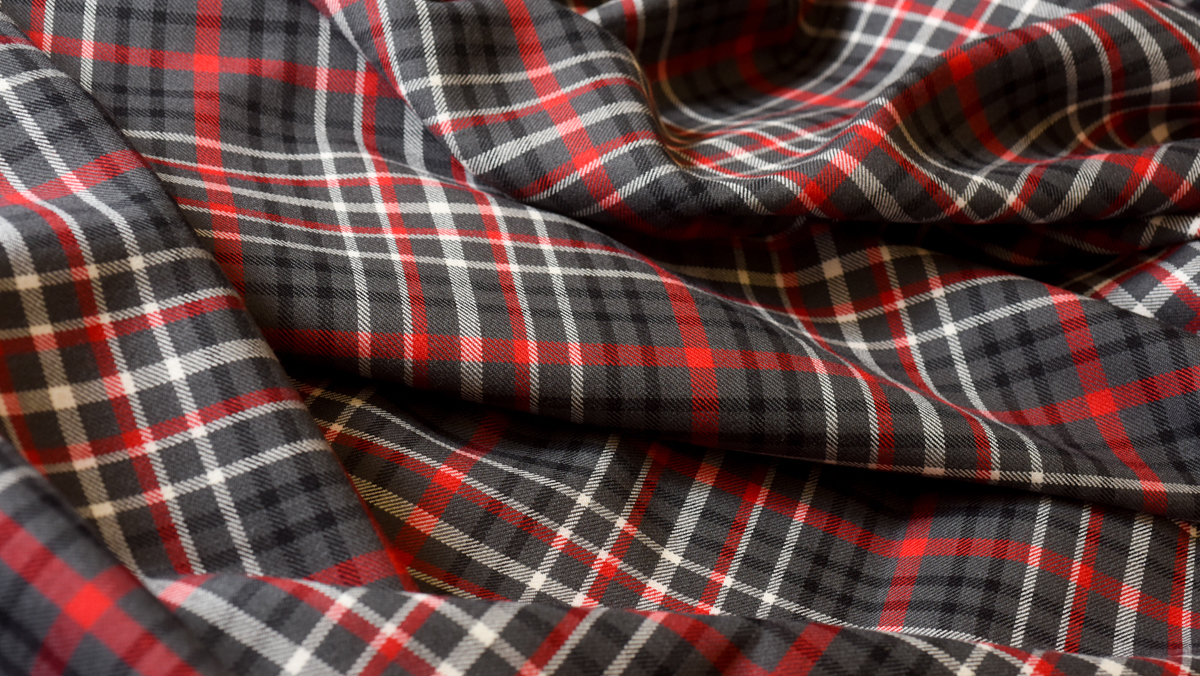Written by Cameron Walker
Kathleen Kelly ‘14 was in her first semester of graduate school at the College of Textiles when she designed the winning entry in NC State’s Pack Plaid contest. Her design, a sophisticated pattern in black, dark gray, red and white, is now listed as the “North Carolina State University — Pack Plaid” in the Scottish Registry of Deeds, the official Scottish register of tartans.
Kelly started taking art classes when she was 4 years old, and made her artistic debut by “improving” upon a work by her grandfather, a painter. He stepped out of the studio for a moment, and while he was gone, she drew all over the unattended painting. The next year, her mother gifted her with her own supplies, including a Crayola fashion design kit; she spent hours creating, drawing motifs on the stenciled clothes.
“I loved it so much,” she said. “But the funny thing was, it wasn’t like I wanted to be a fashion designer. Instead, I wanted to draw the designs on the fabric on the girls’ outfits.”

The Raleigh native earned her bachelor of arts in graphic design from Meredith College in 2007 and then worked as a graphic designer and second shooter for a local photographer. In 2013, she enrolled in the College of Textiles to chase her childhood dream of textile design.
A project for one of her first classes, Textile Technology 570: Textile Digital Design and Technology, was to design a tartan for the Pack Plaid contest. She created and entered several designs using Kaledo Weave software, which allows the user to control factors such as color, pattern and yarn twist.
According to Dr. Cynthia Istook, who created and implemented the Pack Plaid contest, Kelly’s design was the clear winner. From 30 student submissions, university faculty and administrators chose four patterns as semi-finalists; next, alumni and members of the public ranked their favorites.
“Kathleen actually had more than one design chosen to be in the top four,” said Istook. “Her (winning tartan) was the one that came out on top — significantly — with well more than 50 percent of the votes.”
Since it was only her first semester at NC State, she was surprised when one of her tartans won.
“I thought that I had a lack of experience, that maybe mine wouldn’t be as good as everyone else’s,” she said. “But maybe mine turned out better because I was trying to think outside the box.”
Her inspiration was tailored menswear, and she designed her tartan to augment the Wolfpack fan’s existing wardrobe.
“So much of the paraphernalia that’s sold for NC State is predominantly red,” she said. “So I thought that doing something with the gray or black background and just accents of red would coordinate better with the other things that are offered in the bookstore.”
The Pack Plaid contest was not her only win; during her time at NC State, she designed the winning entry in the 2014 College of Textiles bookmark competition. Her entry, also in shades of black, dark gray, red and white, was a clean, graphic design inspired by knitted and woven structures. She won second place in the International Textile Alliance Cover Competition, was juried into the Quintessential Cotton Exhibition for her collection of jacquard woven pillows, and her knit design was published on the cover of “Masterclass: Fashion and Textiles Guide to the World’s Leading Graduate Schools.” During her final semester in 2014, she served as project manager for Coming Home to Cotton, a student competition supported by a grant from Cotton Incorporated; she developed and implemented its web platform, posters, t-shirts, and more, including a book detailing the process. One of her designs was included in the exhibition.
After graduating with her Master of Textiles degree from NC State, she took a position as sample department manager, then knit designer and product developer for CT Nassau, a company that makes mattress tape and fabric, creating mattress fabric for companies such as Casper, Sealy, Serta and Simmons. Kelly recently accepted a new role as textile designer for Creative Ticking/Creative Fabrics, a subsidiary of Beverly Knits, creating fabric for the mattress, automotive and athletic industries. She is also establishing an art licensing business, Kathleen Kelly Creative. Next spring, she will be exhibiting for the first time at SURTEX, a three-day commercial art licensing show for buyers, licensees, manufacturers and retailers.
A Brief History of the Tartan
The tartan has been found in parts of the world dating back as far as 3,000 B.C. — but the patterned cloth has long been associated with Scotland, where tartans have been woven since the 3rd or 4th century A.D. The name itself is likely derived from the French word tiretaine, meaning cloth of woven wool.
What we think of as clan or family tartans originally began as community tartans. Local weavers would sell the same woolen cloth to those in their geographical area, and in time, the community became identified with their unique tartan. The patterns varied in the number and width of intersecting stripes (in repeating tiles called “setts”), as well as color, which was derived from native flora and fauna. The dyes were made from a variety of lichens, seaweeds, whelk, heather, berries and herbs; when woven into a tartan, these hues helped camouflage the wearer with the local landscape for hunting or battle.
The Highland Scots, who lived in the rugged mountainous region of northwest Scotland, were perhaps most identified with the tartan. Their dress became a signifier of insurrection as the Highlanders rose up in support of Bonnie Prince Charlie during the unsuccessful Jacobite rebellion of 1745; after the final clash at the Battle of Culloden, the British throne outlawed the wearing of the tartan with the Dress Act of 1746. The ban endured for nearly 40 years, until its repeal in 1782.
King George IV visited Edinburgh in 1822. He was the first reigning monarch to travel to the country in 171 years, and his arrival was met by a dazzling display of citizens decked out in tartan attire. This pageant, arranged by novelist Sir Walter Scott, kicked off a tartan craze — one which only intensified with a trip to Scotland by his niece, Queen Victoria, and her husband, Prince Albert, two decades later. They visited often, buying Balmoral Castle in 1848 and outfitting it with a variety of tartan patterns; they also created their own tartan designs, the Victoria and the Balmoral. Spurred by an association with Queen Victoria, who also popularized the white wedding dress, the tartan filtered through to the populace.
The Scottish Parliament established the Register of Tartans in 2009. It is housed in the country’s National Archives in Edinburgh and serves as a central, searchable global database for official tartans, like our own Pack Plaid.
This post was originally published in College of Textiles News.
- Categories:



